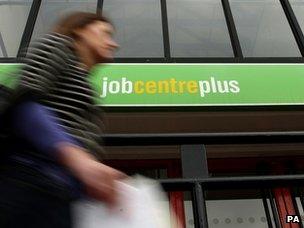The mystery of rising employment
- Published
- comments

How can employment appear to be going up and unemployment down when the economy is so flat?
Always one to revel in a statistical mystery, I have dived into today's employment data to see if I can solve the riddle.
The first thing to point out is that the ONS headline on joblessness, external compares the three months to May with the previous quarter. This shows the number unemployed fell by 65,000. However, employment is highly seasonal, so a far better comparison is with the same period last year. This shows an increase in unemployment of 132,000.
But at first sight, the figures on employment do appear to be more encouraging than one might have expected - an increase of 181,000 on the quarter and, more modestly, an increase of 75,000 year-on-year.
This appears slightly odd since we know how economic growth has basically flat-lined over the last year. Buried within the tables, however, there are some clues as to why this might be.
If one looks at full-time workers one notices an odd thing. Overall, the number of full-time workers has gone up 47,000. Good news.
But the number of employees working full-time has fallen 120,000 and the number of self-employed people working full time has risen by 132,000.
Imagine the scenario: a plumber working for a company is made redundant so decides to set up on his own. As an employee he got paid for every hour he was available for work. As a self-employed person he only gets paid for jobs that he does.
He might describe himself as a full-time self-employed person but a lot of that time may be spent waiting for the phone to ring. His full-time status has not changed but his earnings might well have done.
It is worth pointing out that it is men who are moving out of full-time employment - 161,000 fewer than a year before. Among women the figure has gone up 42,000.
There is also some interesting detail on people who work part time. Among men there has been a significant increase in part-time working, up 3.7%. Among women, however, the proportion has fallen 0.7%. Because more than twice as many women work part time as men, this results in an overall increase in part-time working of just 0.4%.
It is, though, the 4.2% increase in self-employment and 0.6% fall in employment that strikes me as critical in understanding the data. This could be seen as a story of resilience - British workers resolutely refusing to be pushed onto the dole decide to try and make a living on their own.
Only last week I wrote about the youth worker Karen Creed made redundant by Norfolk County Council and now operating as a freelance. Her income has been cut to a third of what it was but she is undoubtedly a full-time self-employed worker.
On the other hand, the employment figures may be lulling us into a false sense of security. We need to know more about what these "full-time self-employed" people are actually doing. It is a worry if a lot of their time is spent waiting for the phone to ring.